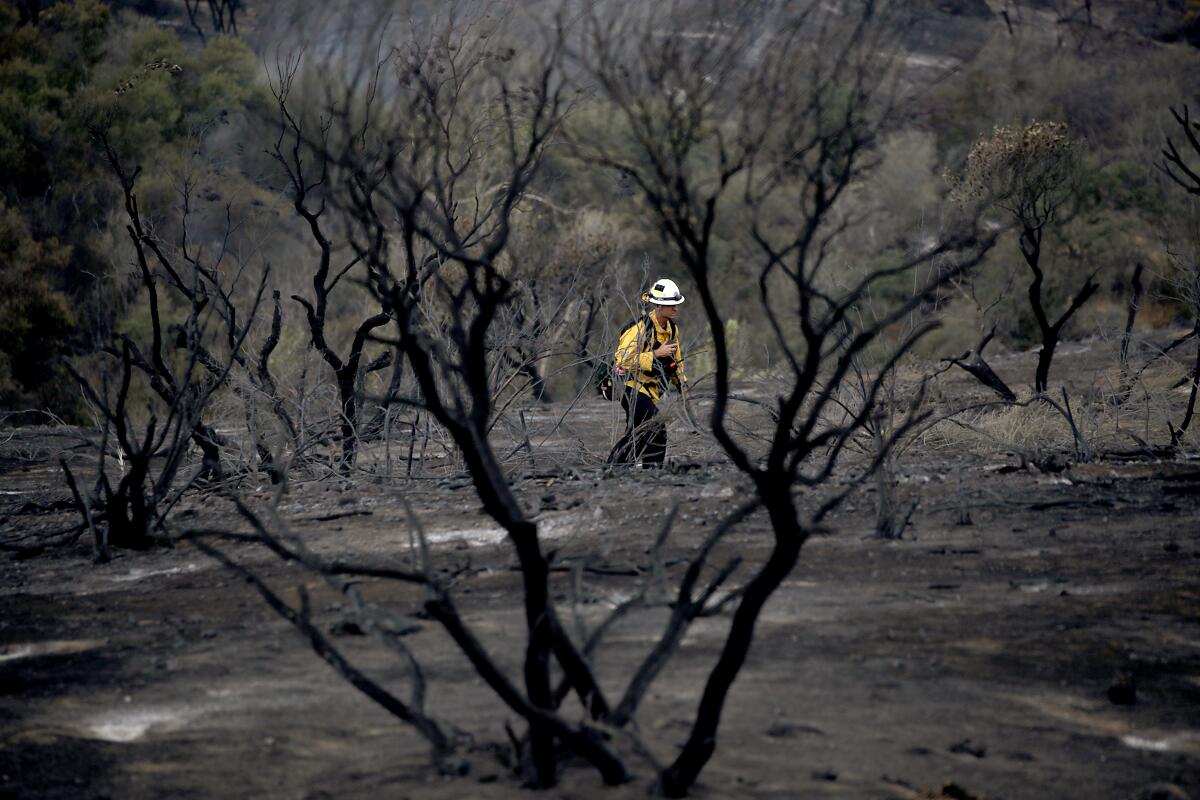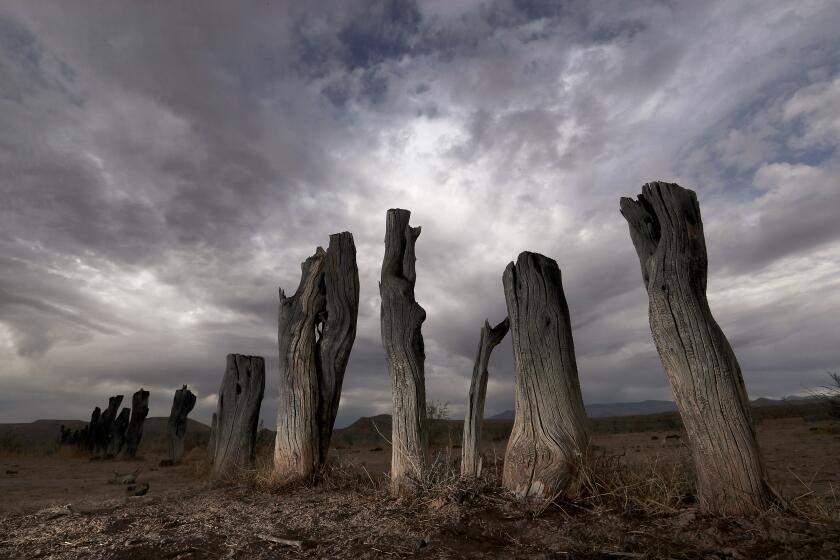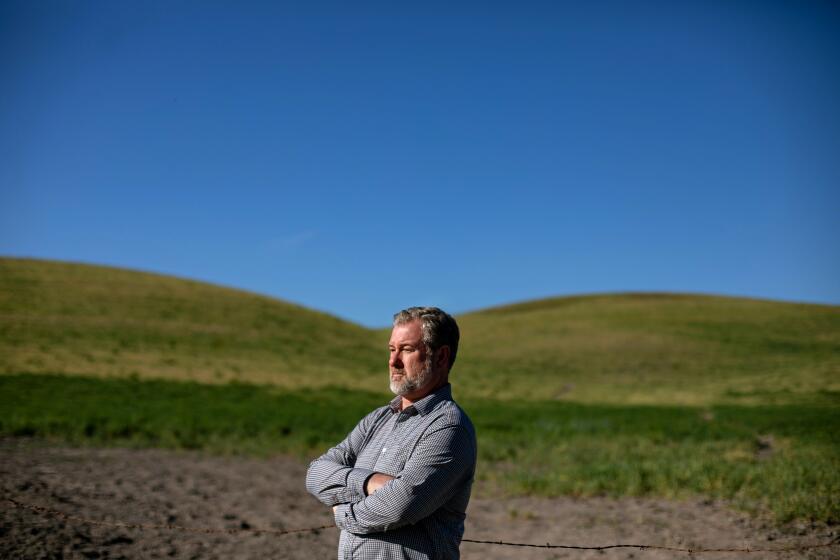Climate change is rapidly accelerating in California, state report says

Wildfires, drought, extreme heat and other effects of climate change are rapidly accelerating and compounding in California, according to a report from state scientists.
The fourth edition of “Indicators of Climate Change in California,” released Tuesday, paints a stark picture of the escalating climate crisis and documents how global reliance on fossil fuels has had wide-ranging effects on the state’s weather, water and residents.
Since the last update in 2018, weather extremes have intensified and become more erratic, officials said, and human health indicators such as heat-related illness, valley fever and wildfire smoke have gotten worse. Some of the changes are irreversible.
“What we find in this report is a continuation and acceleration of the trends we’ve been tracking in earlier editions,” Amy Gilson, a deputy director with the California Office of Environmental Health Hazard Assessment, told reporters. “It’s not just heat, not just water, but that they cascade and compound through the ecosystem, causing the impacts that we’re seeing.”
The West is experiencing its most severe megadrought in a millennium, according to a new study. Scientists say climate change is playing a major role.
The nearly 700-page report focuses on more than 40 key climate indicators and tracks the state’s actions in response. Though much of it is grim, officials said California continues to take “world-leading actions” that could serve as a model for other states, including measures to protect coastal waters, invest in renewable energy resources and phase out gas-powered vehicles.
Still, they stressed, time is not on our side.
“This all needs to be very urgent,” said Yana Garcia, secretary for environmental protection at the California Environmental Protection Agency. “We don’t deny that, and so trying to do our best to respond as quickly as possible is certainly the priority that we have, and to implement the programs that we have moving with as tightened timelines as we possibly can.”
Rising temperatures were among the report’s starkest findings, with annual average air temperatures in California increasing by about 2.5 degrees since 1895 and warming at a faster rate beginning in the 1980s. Eight of the 10 warmest years on record occurred between 2012 and 2022, and temperatures at night have increased by almost three times more than daytime temperatures.
The warmer conditions have affected water availability in the state by causing more precipitation to fall as rain instead of snow, the report says. Extreme heat events and heat waves — both of which have increased in frequency — are also leading to more heat-related illnesses and greater energy strain in order to provide cooling. Low-income communities and people with underlying health conditions are particularly at risk.
Drought conditions have also worsened along with heat, with 2000 to 2021 marking the state’s driest 22-year period over the last 1,000 years in what the report described as “an emerging ‘megadrought’ era.”
One striking finding notes that two snowfields and one of two glaciers in the Trinity Alps disappeared by 2015, with the remaining glacier “arguably too small to be considered a glacier any longer” as of 2021.
Read all of our coverage about how California is neglecting the climate threat posed by extreme heat.
The state’s warming, drying climate is having a profound effect on wildlife and vegetation, including unprecedented tree deaths in California, the report says. An estimated 170 million trees died between 2010 and 2021, including about a third of the conifer forests in the southern Sierra Nevada.
Vegetation is also more primed to burn, and wildfires across the state have increased dramatically over the last 20 years. Ten of the 20 largest wildfires since 1950 burned in 2020 and 2021, including the record-breaking August Complex, which surpassed 1 million acres in 2020 to become the state’s first “gigafire.”
“It is troubling how some of the changes are occurring a lot faster than was expected even a few years ago,” said Carmen Milanes of the Office of Environmental Health Hazard Assessment.
Also troubling are the secondary consequences of the state’s climate changes, such as declining populations of birds and mammals due to hotter, drier conditions. Warming river waters have contributed to such huge declines in Chinook salmon populations that they have been designated as a threatened species.
“California’s biodiversity is threatened as alterations to habitat conditions brought about by a changing climate are occurring at a pace that could overwhelm the ability of plant and animal species to adapt,” the report says.
Humans are suffering too, including through increased exposure to harmful wildfire smoke. During the record-breaking 2020 wildfire season, smoke plumes were present in every county for at least 46 days, the report says, and air quality particulate levels remained hazardous for weeks.
The report also says occupational heat-related illnesses are increasing, as are incidents of valley fever, a fungal infection linked to dry soil conditions.
Bouts of extreme precipitation, along with worsening drought and heat, are creating more of the dangerous dust, experts say.
Though the findings were troubling, officials emphasized California’s slate of aggressive climate measures, including a record $54-billion investment in climate action from Gov. Gavin Newsom this year. Newsom also signed a suite of legislation aimed at reducing the state’s oil consumption and cutting air pollution, among other goals. The state seeks to achieve carbon neutrality no later than 2045 and 90% clean energy by 2035.
Garcia said two areas in which the state is accelerating its actions are water supply issues and air quality, including through the deployment of electric vehicles.
“The way that we consider our ability to influence climate action comes in large part from our ability to drive markets and economic growth, technological innovation,” she said, “and I think we see quite a bit of that particularly in the vehicle space.”
The state is also showing progress on emissions, with the report noting that greenhouse gas emissions from human activities have been trending downward since 2004 even as the population has grown. However, a recent study from UCLA indicated that wildfire emissions, which were not previously counted, may have reversed most of those efforts.
“The stark data that we’ve now become aware of is extremely concerning,” Garcia said of that study. “Part of what is our job to continue to do is double down on the efforts to reduce wildfire risk, to manage wildfire safely.”
And while California is seeing “quite a bit of investment flow from the federal government” to help with infrastructure, drinking water and other challenges, she said more is needed. Nearly a million Californians are living with unsafe drinking water, and more than 1,300 dry wells have been reported this year.
“The infrastructure investments that we’ve made to date could benefit from additional investments from our federal colleagues, from our federal partners,” she said.
Plenty of challenges lie ahead as California mandates zero-emission cars, including cost and access to charging.
Also new to the report this year was the state’s collaboration with more than 40 California tribes, including the Santa Ynez Band of Chumash Indians, the Karuk Tribe and the Bishop Paiute Tribe, which contributed to the assessment.
“Warming temperatures, changing precipitation patterns, and intensifying droughts have increased reliance on groundwater, degraded aquatic habitat, stressed vegetation, and diminished previously abundant wildlife,” the report says. “As the environment is impacted by climate change, Tribal health suffers.”
The report also spotlighted emerging climate issues, which are “plausibly influenced by climate change, though not yet established.” Such issues include reductions in coastal fog, increased frequency of harmful algal blooms and increased lightning activity, the report says.
Increased allergen levels, food- and waterborne infections, and zoonotic diseases shared between humans and other animals were also among the emerging issues.
The findings of the report were “not necessarily surprising, but troubling,” Milanes said, both because of the rate of change and the compounding effect of various impacts.
More to Read
Sign up for Essential California
The most important California stories and recommendations in your inbox every morning.
You may occasionally receive promotional content from the Los Angeles Times.















